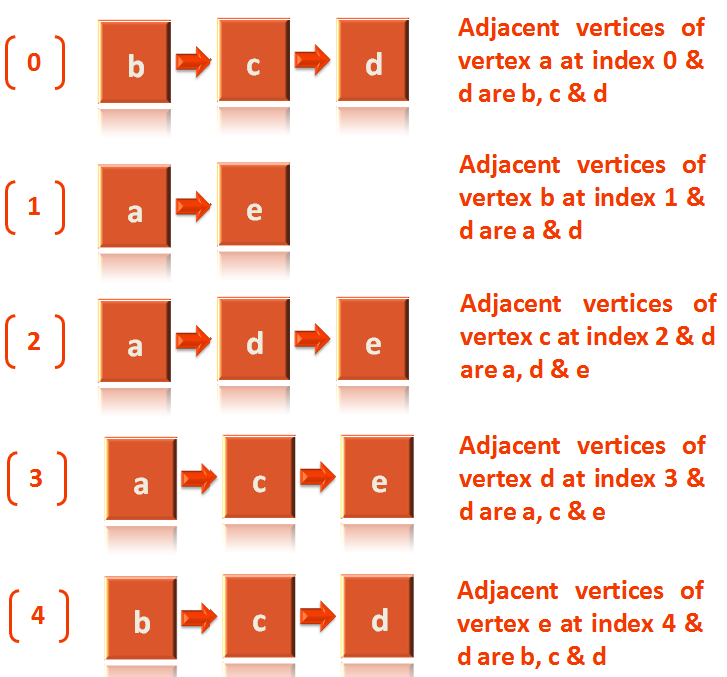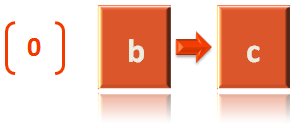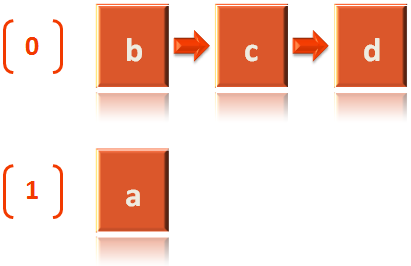

import java.util.LinkedList;
class AdjacencyListGraph {
fun insertVertex(vertices: LinkedList<String>, vertex: String) {
vertices.add(vertex);
}
fun constructAdjacencyList(adjcList: LinkedList<LinkedList<String>>, u: Int, value: String) {
adjcList.add(LinkedList<String>());
adjcList.get(u).add(value);
}
fun printAdjacencyList(adjcList: LinkedList<LinkedList<String>>, vertices: LinkedList<String>) {
var i = 0;
for (vtx in vertices) {
println("The Adjacency List for vertex $vtx at index $i :");
for (j in 0..(adjcList[i].size-1)) {
print("${adjcList[i][j]} --> ");
}
println("\b\b\b\b");
i++;
}
}
}
fun main(arr: Array<String>) {
var adjacencyListGraph = AdjacencyListGraph();
var vertices = LinkedList<String>();
var adjacencyList = LinkedList<LinkedList<String>>();
// Insert Vertices
adjacencyListGraph.insertVertex(vertices, "a");
adjacencyListGraph.insertVertex(vertices, "b");
adjacencyListGraph.insertVertex(vertices, "c");
adjacencyListGraph.insertVertex(vertices, "d");
adjacencyListGraph.insertVertex(vertices, "e");
// Create Adjacency List
adjacencyListGraph.constructAdjacencyList(adjacencyList, 0, "b");
adjacencyListGraph.constructAdjacencyList(adjacencyList, 0, "c");
adjacencyListGraph.constructAdjacencyList(adjacencyList, 0, "d");
adjacencyListGraph.constructAdjacencyList(adjacencyList, 1, "a");
adjacencyListGraph.constructAdjacencyList(adjacencyList, 1 ,"e");
adjacencyListGraph.constructAdjacencyList(adjacencyList, 2, "a");
adjacencyListGraph.constructAdjacencyList(adjacencyList, 2, "d");
adjacencyListGraph.constructAdjacencyList(adjacencyList, 2, "e");
adjacencyListGraph.constructAdjacencyList(adjacencyList, 3, "a");
adjacencyListGraph.constructAdjacencyList(adjacencyList, 3 ,"c");
adjacencyListGraph.constructAdjacencyList(adjacencyList, 3, "e");
adjacencyListGraph.constructAdjacencyList(adjacencyList, 4, "b");
adjacencyListGraph.constructAdjacencyList(adjacencyList, 4, "c");
adjacencyListGraph.constructAdjacencyList(adjacencyList, 4, "d");
adjacencyListGraph.printAdjacencyList(adjacencyList, vertices);
}
There are two methods in the above code :
While the first method is quite simple.
fun insertVertex(vertices: LinkedList<String>, vertex: String) {
vertices.add(vertex);
}As the name of the method fun insertVertex(...) suggests. The method is used to add vertices to the Linked List.
Let us take the example to add the vertex a to the Linked List.
So, in the main(...) method, we have created a Linked List to hold the vertices.
var vertices = LinkedList<String>();
Then we call the fun insertVertex(...) method and pass the Linked List vertices and the vertex a to the method.
adjacencyListGraph.insertVertex(vertices, "a");
Now, if we go to the definition of the fun insertVertex(...) method. We can see, there is just one line in it,
vertices.add(vertex);
That takes the vertex (a in this case) and adds it to the vertices Linked List.
Next, let us come to the next method that creates the Adjacency List.
fun constructAdjacencyList(adjcList: LinkedList<LinkedList<String>>, u: Int, value: String) {
adjcList.add(LinkedList<String>());
adjcList.get(u).add(value);
}Let's start with at the main(...) method. Where we have defined a 2D Linked List to hold the Adjacency List.
var adjacencyList = LinkedList<LinkedList<String>>();
But why do we need a 2D Linked List ?
Let us look at the below diagram to get it clarified.
Vertex a is at index 0. Similarly, vertex b is at index 1 and so on.

Now, we can consider the above as a 2D Linked List.
But How ?
Let us take vertex a at index 0. Then take its Adjacent Vertices and pass it to fun constructAdjacencyList(...) method.
adjacencyListGraph.constructAdjacencyList(adjacencyList, 0, "b");
The first adjacent vertex of a at index 0 is b. So, we pass the index i.e. 0 and its adjacent vertex i.e. b.
Now let's go to the fun constructAdjacencyList(...) method definition.
And we come across the first line :
adjcList.add(LinkedList<String>());
Now, since adjcList is a 2D Linked List, we need to initialise the first row(As mentioned in the diagram) with a Linked List (i.e. LinkedList<String>())
And this row will hold the Adjacent vertices of vertex a at index 0 (i.e. b, c & d)
And then comes the line that will be adding elements to the above created Linked List.
adjcList.get(u).add(val);
So, in the above line, the first thing we do is, get the Linked List at index 0
adjcList.get(0) [Since the value of u is 0]
Then, add b to the Lined List.
adjcList.get(0).add("b"); [Since, the value of val is b].And the below Linked List is formed.

Then, we come to the next line in the main(...) method.
adjacencyListGraph.constructAdjacencyList(adjacencyList, 0, "c");
The second adjacent vertex of a at index 0 is c. So, we pass the index i.e. 0 and its adjacent vertex i.e. c.
Now let's come to the fun constructAdjacencyList(...) method definition.
And we come across the first line :
adjcList.add(LinkedList<String>());
And then comes the line that will be adding elements to the above created Linked List.
adjcList.get(u).add(val);
So, in the above line, the first thing we do is, get the Linked List at index 0
adjcList.get(0) [Since the value of u is 0]
Then, add c to the Lined List.
adjcList.get(0).add("c"); [Since, the value of val is c].And the below Linked List is formed.

Similarly, we come to the next line in the main(...) method.
adjacencyListGraph.constructAdjacencyList(adjacencyList, 0, "d");
The second adjacent vertex of a at index 0 is d. So, we pass the index i.e. 0 and its adjacent vertex i.e. d.
And the below Linked List is formed.

Now, us take vertex b at index 1. Then take its Adjacent Vertices and pass it to fun constructAdjacencyList(...) method.
adjacencyListGraph.constructAdjacencyList(adjacencyList, 1, "a");
The first adjacent vertex of b at index 1 is a. So, we pass the index i.e. 1 and its adjacent vertex i.e. a.
Now let's go to the fun constructAdjacencyList(...) method definition.
And we come across the first line :
adjcList.add(LinkedList<String>());
Now, since adjcList is a 2D Linked List, we need to initialise the 2nd row(As mentioned in the diagram) with a Linked List (i.e. LinkedList<String>())
And this row will hold the Adjacent vertices of vertex b at index 1 (i.e. a & e).
And then comes the line that will be adding elements to the above created Linked List.
adjcList.get(u).add(val);
So, in the above line, the first thing we do is, get the Linked List at index 1
adjcList.get(1) [Since the value of u is 1]
Then, add 1 to the Lined List.
adjcList.get(1).add("a"); [Since, the value of val is a].And the below Linked List is formed.

And continuing this way we get the Adjacency List.